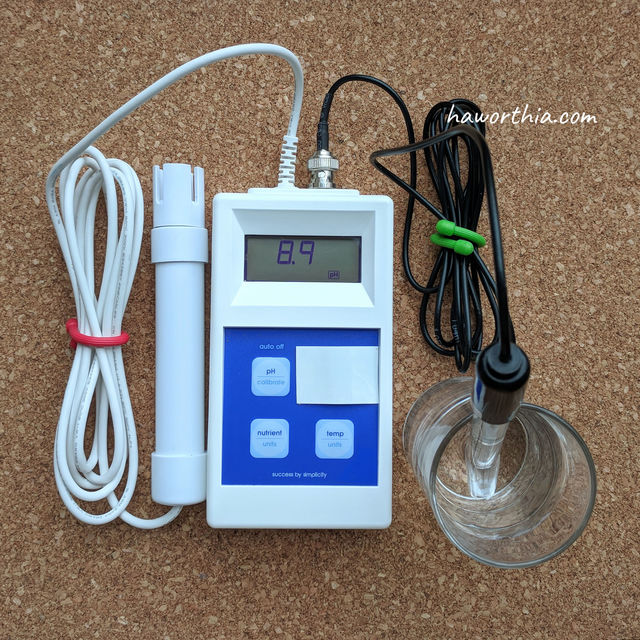Fertilizing
The best strategy to fertilize Haworthias is to supply a continual low concentration in every watering. By linking nutrient supply with watering, a plant always gets adequate nutrients in proportion to the water uptake, regardless of its size and growth stage. Besides, some elements (for example, Calcium and Silicon) are immobile in plant tissues and must be supplied at all times.
Essential Elements
Besides the big 3 elements: nitrogen, phosphorus, and phosphorus (NPK), Haworthias also need other elements for optimal growth. Giving Nitrogen the value of 100, the table below lists the ideal ratios of weights of 14 essential elements, based on how much they are found in plant tissues. An unbalanced supply may lead to nutrient deficiency and even toxicity.
| Element | Ideal Range | Optimal Value |
|---|---|---|
| Nitrogen (N) | 100 | |
| Phosphorus (P) | 13-19 | 16 |
| Potassium (K) | 45-80 | 62 |
| Sulfur (S) | 6-9 | 8 |
| Magnesium (Mg) | 5-15 | 10 |
| Calcium (Ca) | 5-15 | 10 |
| Iron (Fe) | 0.7 | |
| Manganese (Mn) | 0.4 | |
| Boron (B) | 0.2 | |
| Zinc (Zn) | 0.06 | |
| Copper (Cu) | 0.03 | |
| Chlorine (Cl) | 0.03 | |
| Molybdenum (Mo) | 0.003 | |
| Optional: Silicon (Si) | 86 |
Ideally, find a fertilizer that has N-P-K label in 3:1:2 (for example, 24-8-16, 12-4-8, 9-3-6) and contains the other elements in the list above. 3:1:2 corresponds to the weights of NPK elements closest to the 100:16:62 ratio above (how to calculate). If some elements are lacking, there are fertilizers dedicated to supplying them as well. Note that if tap water is used for watering, check the water quality report as the water may already have some elements (often Ca and Mg) well represented.
Avoid Urea-Based Fertilizers
Haworthias prefer an acidic growing medium. However, low pH makes the conversion of urea to Nitrogen usable by plants slow.
It is recommended to use synthetic fertilizers because they dissolve in water and in most cases, are available for immediate uptake. This allows the nutrient supply to be accurately controlled. In contrast, organic fertilizers need to be decomposed before being usable. The decomposition process is affected by many factors (for example, moisture, pH level, and temperature) and the nutrient supply is, therefore, less stable.
Concentration
For Haworthias, the ideal concentration of Nitrogen in a water solution is ~0.006% (for an NPK 9-3-6 fertilizer, 2/3 mL per 1 L water), and the concentrations of the other elements should be based on the above ratios. When adding fertilizers, one fertilizer should be fully diluted in water before adding another. Otherwise, there can be undesired chemical reactions between concentrated fertilizers.
Acidity
The acidity of a water solution is a major determinant of balanced nutrient uptake. The ideal pH range for Haworthias is 5.0~5.5 (5.2 optimal). After diluting fertilizers in water, test with a pH meter and apply pH adjusters until the desired pH is reached. Hydrochloric acid is a good acidifier because others often result in chemical by-products which could negatively impact plants.

Another advantage of acidified water solutions is that they are likely to leave watermarks on the leaves of Haworthias.
